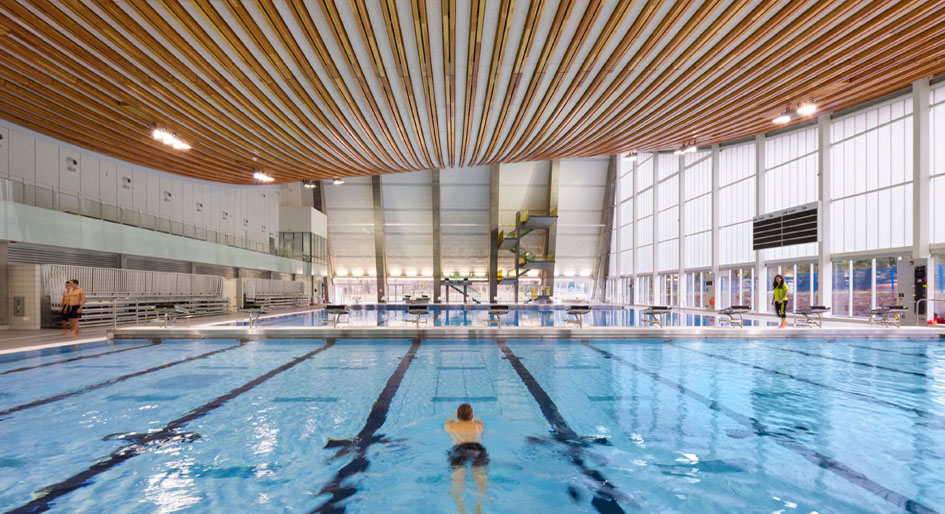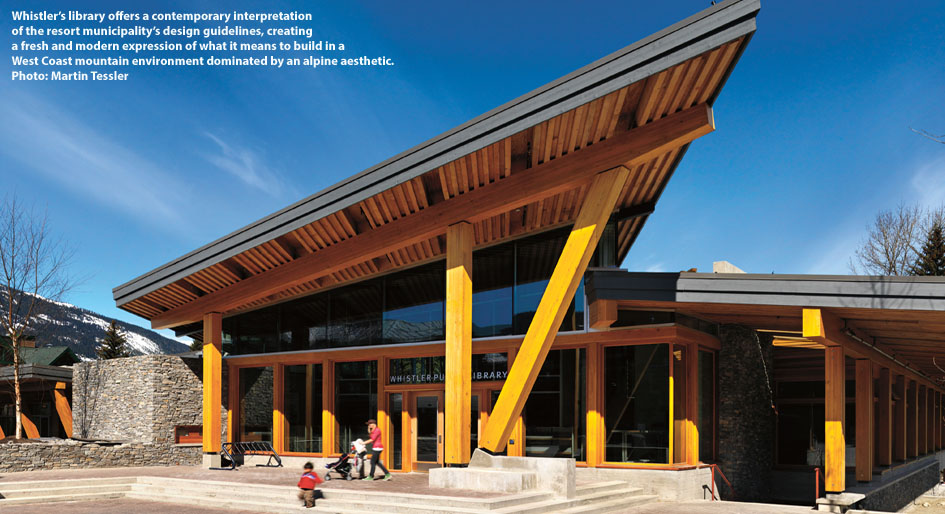Darryl Condon and his firm, HCMA Architecture + Design, have embraced and often pioneered the use of wood and mass timber in community, civic, and recreational aquatic facilities throughout British Columbia and Canada. Condon shares why wood is often an integral material in the buildings they design, and how they’ve pushed the boundaries of what is possible with wood.
Q: Why have you made community centres and recreation facilities a significant focus for your firm?
A: There are many aspects of responsibility that come with the privilege of designing community buildings. These facilities play a vital role in civic life and ultimately in helping to shape strong, just, and cohesive communities. At HCMA, we strive to challenge the traditional boundaries of architectural practice and become catalysts for positive change. Good architecture, I believe, builds community in many ways, but central to this is providing the context for positive social engagement. Whether it be a library, a school, an ice arena, or a swimming pool, they accommodate functions—yet these activities can be seen as a means to a greater end: building community.
Q: What role does wood, as a building material, play in the facilities you design?
A: As a firm we have been exploring the many ways that we can achieve better social outcomes, both through our work and the tools and methodologies we use in the process. For us, the use of wood in community facilities is directly linked to this. The environmental benefits of wood are increasingly well understood, but it is important to recognize the broader social sustainability benefits as well. We are fortunate to have many municipal clients that embrace this mandate and we have enjoyed their support as we have explored the nature and capacity of wood construction. As British Columbians, it makes sense that we are drawn to building with wood and we’ve really embraced pushing the envelope with what you can do with wood, such as with Grandview Heights Aquatic Centre.
Q: For Grandview, how were you able to achieve such an astonishing structural feat using wood?
A: Grandview Heights Aquatic Centre is the result of a great, forward-thinking client and a passionate architectural design and structural engineering team. We were encouraged by our client, the City of Surrey, to pursue an innovative solution for the project. Here, we tested the limits of wood to be used in long-span buildings by developing a tensile roof structure, using engineered wood cables that use steel only in their connections. We have long recognized the inherent benefits of utilizing wood in indoor swimming pools; wood is a great solution to the challenges of chlorine and humidity. While analyzing or renovating older swimming pools, we see the wood structures standing up to these rigours very well. It’s been a material of choice for all of our recent aquatic facilities. At Grandview, the nature of the wood structural system also provided a visceral expression of fluidity, waves, and water, while being an incredibly efficient design. Here, function and beauty are one—the wood structure is the architecture, and the architecture is the structure.
 Photo: Located in Surrey, Grandview Heights Aquatic Centre contains a sixty-five-metre-long catenary roof – the longest clear span of its kind prefabricated from regionally sourced Douglas-fir beams crane-lifted into place in just eight days.
Photo: Located in Surrey, Grandview Heights Aquatic Centre contains a sixty-five-metre-long catenary roof – the longest clear span of its kind prefabricated from regionally sourced Douglas-fir beams crane-lifted into place in just eight days.
Photo: Ema Peter Photography
Q: As an early pioneer with wood in B.C., what is an innovative wood project you are particularly proud of?
A: A notable project for us is the Whistler Public Library, which was completed in 2008. For the Resort Municipality of Whistler, this project had many aspirations including the goal of providing a uniquely civic place in a primarily commercial resort community. The use of wood, while not mandated, was a natural choice to create a new and authentically local language for civic architecture in a mountain community. At the time, a mass-timber approach was not an obvious choice, as more materially efficient structural solutions were the norm. We explored a variety of wood solutions, but ultimately settled on a prefabricated wood panel system utilizing one-hundred by three-hundred–millimetre hemlock members fastened together in an early and innovative form of mass-timber construction. The western hemlock was significant, as we were able to demonstrate the structural potential for an often-overlooked species, one that is abundant near many resource-dependent communities.
Q: Where will you go next when it comes to pushing the boundaries with wood?
A: From the lessons learned from Whistler Public Library, and others, we have been able to integrate a mass-timber approach in a variety of building types, including schools, fire halls, and swimming pools. Every project is unique and offers new possibilities. Who knew we would achieve the world’s longest span of a timber catenary roof, as we did with Grandview Heights Aquatic Centre? Wood is a limitless material in so many ways—renewable, and with extraordinary expressive potential. That it fits so well with the role and mandate of community facilities means that we will be continuing to explore and imagine new possibilities in the future.
These projects and others are featured in a newly released book, Naturally Wood, which showcases British Columbia’s cutting‐edge wood architecture and design. The beautifully illustrated, 160-page publication contains more than 65 innovative wood buildings and projects, including how wood is being used in pools and arenas.
Four continuing education units have been developed based on the book. They are recognized by the Architectural Institute of British Columbia and are available at naturallywood.com/naturally-wood-ceus.
Download the Naturally Wood e-book at naturallywood.com/nwbc.









